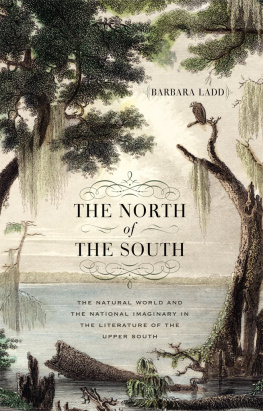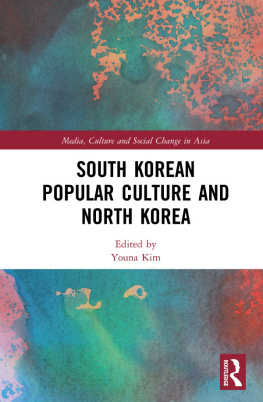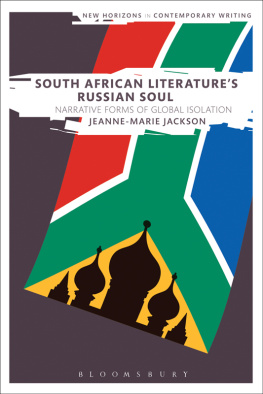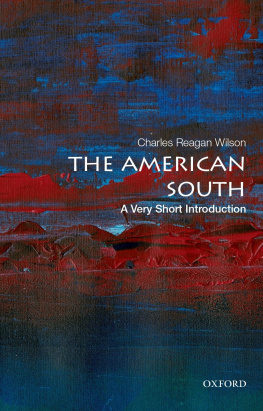The North of the South
Mercer University Lamar Memorial Lectures No. 59

THE NORTH OF THE SOUTH
The Natural World and the National Imaginary in the Literature of the Upper South

BARBARA LADD
THE UNIVERSITY OF GEORGIA PRESS
Athens
2022 by the University of Georgia Press
Athens, Georgia 30602
www.ugapress.org
All rights reserved
Set in 10/14 Sabon by Rebecca A. Norton
Most University of Georgia Press titles are available from popular e-book vendors.
Printed digitally
Library of Congress Cataloging-in-Publication Data
Names: Ladd, Barbara, author.
Title: The north of the South : the natural world and the national imaginary in the literature of the upper South / Barbara Ladd.
Description: Athens : The University of Georgia Press, 2022. | Series: Mercer University Lamar memorial lectures; 59 | Includes bibliographical references and index.
Identifiers: LCCN 2022010892 | ISBN 9780820362519 (hardback) | ISBN 9780820362526 (paperback) | ISBN 9780820362533 (ebook)
Subjects: LCSH: American literatureSouthern authorsHistory and criticism. | Nature in literature. | Southern StatesIn literature. | Southern StatesIntellectual life.
Classification: LCC PS261 .L336 2022 | DDC 810.9/975dc23/eng/20220418
LC record available at https://lccn.loc.gov/2022010892
Contents


The subjects I take up in this book and in the talks from which it is derived have been uppermost in my mind for years, and I would like to extend my sincere thanks to Mercer University and to the Lamar Memorial Lectures Committee for their invitation to speak. Had I not received Doug Thompsons call, I doubt the project would have taken the direction it has taken, and I doubt that a longer book on these subjects would be in the works.
My visit to Mercer was both an honor and a pleasure, from beginning to end, and I want to extend my sincere thanks to David Davis, Sarah Gardner, and Andrew Silver, as well as to Doug, for making my visit such a pleasant one. Bobbie Shipley made sure that everything was in order and running smoothly, no simple matter when hosting a university visitor, as I well know; my thanks to her as well. And thanks also to Bethany Snead, Jon Davies, and others at the University of Georgia Press, as well as Arthur Johnson, for much expert assistance.
The teachers, scholars, and writers I reference in this book, and many whom I have not referenced, have given me more over the years than I can properly thank them for.
The North of the South

Over the past generation the Deep South has become the primary site and the plantation the predominant referent in southern literary studies, developments that have followed academic interest, first in postcolonial studies and more recently in globalization studies and its Global South terrain. In this book, Id like to divert some attention northward, to the Upper South, to the North of the South.
To be sure, the work that has come out of what we might call Global American South studies continues to be important and calls our attention to the many ways in which the cultures of the southern United States are tied to cultures to the south of the American Souththe Caribbean, Africa, and Central and South America have been of most interest to students of the U.S. South. My first book, Nationalism and the Color Line in George W. Cable, Mark Twain, and William Faulkner (published what seems like a lifetime ago, in 1996), helped to inaugurate the Caribbean turn in southern studies. Since that time, more (and better) work has appeared, and I remain interested in the revelations of Global American South studies.
Lately, however, I have become more interested in the Upper South, in the British rather than the French and Spanish colonies, and in the quite different cultures and literatures we find coming out of Virginia, Maryland, Delaware, North Carolina, Tennessee, and Kentucky. As historians like Jack P. Greene have reminded us, plantations in the Upper South were initially established by people who proposed to settle in the New World and brought their families (unlike many of those in the French and Spanish territories of what is now the Deep South and in the Global South more broadly). The descendants of those settlers became central figures in the American Revolution, the first New World war of independence.
Upper South plantations were different in other ways. They shared more of the land with farms and towns. They were sometimes smaller and, importantly, less stable over timeplantations in the Upper South began to fail by the early nineteenth century, only a generation after the American Revolution. In part, this had to do with the fact that tobacco production exhausted the soil so quickly; and although the Sugar Revolution made fortunes for planters in the Deep South and the Caribbean, the Upper South was hardly suitable for sugar agriculture, or even for cotton production on a large scale. As a result, some planters sent their sons into lands newly acquired from France in the Deep South to recoup, while others migrated across the Appalachians into Tennessee and Kentucky, and farther still, into the Midwest.
In the Upper South we find a more, or at least differently, diverse population as well. There was a large population of free persons of color, for example, some of whom descended from laborers brought from Africa in the decades before slavery began to be codified for persons of African descent in the middle of the seventeenth century. The post-contact history of Native American cultures in the Upper South more closely resembles the history of such cultures in New England and the Mid-Atlanticin short, Native Americans were pushed westward earlier in the Upper South than in the Deep South. And proximity to the Mid-Atlantic made some cities, such as Richmond and Baltimore, more like Philadelphia and New York than like New Orleans.
In fact, the boundary between the Upper South and the Mid-Atlantic has always been uncertain, as has the boundary between the Upper South and the Midwest (although the fluidity of the latter is more often recognized). As one historian reminds us, the very category of middle colonies and middle states was late to develop, and a case can be made that what we today think of as the Mid-Atlantic (New York, Pennsylvania, Delaware, New Jersey, Maryland) was actually two regions during the colonial period and in the Early Republic, with New York and New Jersey being more closely aligned, culturally and economically, with New England, and Pennsylvania, Maryland, and Delaware more closely aligned with Virginia. Moreover, Virginia itself has at times been classified as a middle state (Gough 397401).
None of this is to say that Virginia, Delaware, and Maryland were not part of the plantation complex. They were, as were parts of New Jersey, New York, and Massachusetts. However, turning our attention to the Upper South recasts southern culture vis--vis the American project, the Global South, and the Global North in ways that can illuminate the role not only of the plantation but of life beyond the plantation proper in the national project and in the literary imaginations of southerners in and beyond the North of the South. It calls into question the rigid mapping of regions in American literary and cultural studies and challenges some of the fixed ideas we still have about American regional differences.








